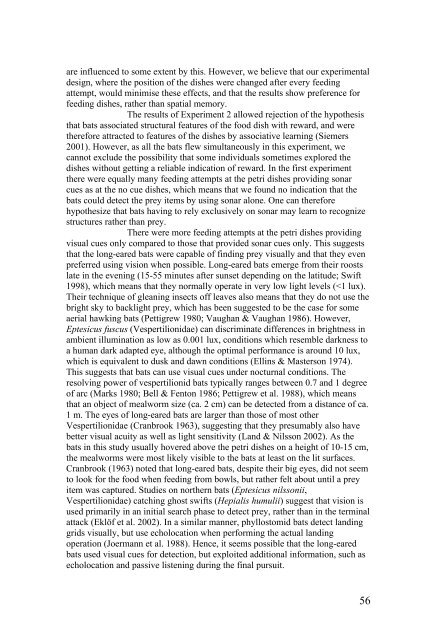Vision in echolocating bats - Fladdermus.net
Vision in echolocating bats - Fladdermus.net
Vision in echolocating bats - Fladdermus.net
Create successful ePaper yourself
Turn your PDF publications into a flip-book with our unique Google optimized e-Paper software.
are <strong>in</strong>fluenced to some extent by this. However, we believe that our experimental<br />
design, where the position of the dishes were changed after every feed<strong>in</strong>g<br />
attempt, would m<strong>in</strong>imise these effects, and that the results show preference for<br />
feed<strong>in</strong>g dishes, rather than spatial memory.<br />
The results of Experiment 2 allowed rejection of the hypothesis<br />
that <strong>bats</strong> associated structural features of the food dish with reward, and were<br />
therefore attracted to features of the dishes by associative learn<strong>in</strong>g (Siemers<br />
2001). However, as all the <strong>bats</strong> flew simultaneously <strong>in</strong> this experiment, we<br />
cannot exclude the possibility that some <strong>in</strong>dividuals sometimes explored the<br />
dishes without gett<strong>in</strong>g a reliable <strong>in</strong>dication of reward. In the first experiment<br />
there were equally many feed<strong>in</strong>g attempts at the petri dishes provid<strong>in</strong>g sonar<br />
cues as at the no cue dishes, which means that we found no <strong>in</strong>dication that the<br />
<strong>bats</strong> could detect the prey items by us<strong>in</strong>g sonar alone. One can therefore<br />
hypothesize that <strong>bats</strong> hav<strong>in</strong>g to rely exclusively on sonar may learn to recognize<br />
structures rather than prey.<br />
There were more feed<strong>in</strong>g attempts at the petri dishes provid<strong>in</strong>g<br />
visual cues only compared to those that provided sonar cues only. This suggests<br />
that the long-eared <strong>bats</strong> were capable of f<strong>in</strong>d<strong>in</strong>g prey visually and that they even<br />
preferred us<strong>in</strong>g vision when possible. Long-eared <strong>bats</strong> emerge from their roosts<br />
late <strong>in</strong> the even<strong>in</strong>g (15-55 m<strong>in</strong>utes after sunset depend<strong>in</strong>g on the latitude; Swift<br />
1998), which means that they normally operate <strong>in</strong> very low light levels (


